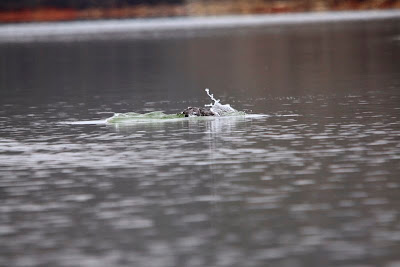click on photos to enlarge
How bout that catchy title to this entry. Loonscapes. Oh well; its my blog. I went down to the old ruins today to photograph birds and found that the birds flew the coop. Alright; I'll settle down with the cutesy phrases. After an hour of gradually freezing; I took off to the lake. I figured I might catch a mallard or a goose down there. Maybe a coot would be swimming around. I pulled up to the lake and to my surprise there were loons swimming just off shore. The loon is one bird I have been trying to photograph for years. What a chance! I crawled out on the grassy bank as far as I could and acted disinterested in the birds. I thought I might pass as a blown over garbage can just laying there on the ground. That didn't fool the loons for long. They are really hard to get close to. This would be a good opportunity to try out this 500 mm lens.
These loons are known as the common loon. They are in their winter plumage and on their Winter range. They winter in waters that are surrounded by lush forests and also on coastal waters. Their plumage will change into their breeding colors in the Spring when they will migrate to points north. They're range is from British Colombia, across Canada to New Brunswick and most of the Northern States. A common loon can dive a hundred feet or more.They have been caught in fishing nets as deep as two hundred feet. It is a privilege to be able to observe and photograph these magnificent birds. I am looking forward to photographing them in their breeding colors.
Loons subsist primarily on small fish. They also eat crayfish, shell fish, large aquatic insect larva and the occasional snake. The acid rain situation has depleted the loon's food source on many lakes in the far North. Don't be surprised if it makes it's debut on the endangered species list in a few more years. A terrible shame!
An interesting note: One will not see a loon on a tree limb and never walking on the shoreline. They have been confused with the cormorant. They can be seen in wet marshy lands where they nest. The reason? The loon's legs are placed too far rearward on it's body to support and balance it's weight on land. I's called evolution. Of course; there is always that circumstance where the norm is contradicted. But; it is a fact that the loon has all but given up walking on land.
Have you ever heard the story of the loon that has died because he was stuck on a frozen lake? He stays on and on until the water freezes close around him. He bobs about in his small ten yard diameter space unable to fly. He can not walk out of his situation because his legs are useless. He needs space to fan his wings and gain lift off the water. He needs distance to gain speed. A duck or goose would simply hop up on the ice and lift off. Not so the loon.I don't know when loons connect to become a mating pair. It seems that they are swimming in pairs today. It may not be so but, it appears they are staying very close together. Where one goes; so goes the other.
I'll post some more pictures up here without comment. Enjoy this beautiful, elusive bird. Well; I'll try not to comment.
DIVE! DIVE! DIVE!
Ok; I'll be quiet
Note the color of the beak
This bird kept his eye on me at all times. I was the last thing he saw when he would dive and I was the first thing he saw when he surfaced. Amazing bird!
He just caught a fish but, it is very hard to see it
We've got to flap the water off our wings after a dive
And yet another dive
This loon is very far out in the lake. I wasn't sure if the photo would be worthy of posting.
How gorgeous!






















No comments :
Post a Comment
I appreciate your interest in my blog and welcome your comments